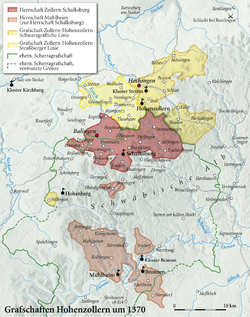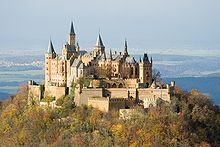- Zollern
-
County of (Hohen-)Zollern
Grafschaft (Hohen-)ZollernState of the Holy Roman Empire ← 
1052–1576  →
→
 →
→
 →
→

Flag Coat of arms Motto
Latin: Nihil Sine Deo
(English: Nothing without God)Hohenzollern territories about 1370 Capital Hechingen Language(s) German Religion Roman Catholic Government Principality Historical era Middle Ages - Established 1052 - Partitioned 1576 - Reunited as Prussian
Province of Hohenzollern
1850Zollern, from 1218 Hohenzollern, was a county of the Holy Roman Empire. Its ruling dynasty was the House of Hohenzollern, a Swabian noble family first mentioned in 1061. They named their estates after Hohenzollern Castle at the Swabian Alb; its capital was Hechingen. Its coat of arms was that of the ruling house.
According to the mediæval chronicler Berthold of Reichenau, the nobleman Burkhard I, Count of Zollern (de Zolorin) was born before 1025 and died in 1061. By his name, an affiliation with the Alamannic dynasty of the Burchardings is possible, though not proven. The Zollerns received the comital title from Emperor Henry V in 1111. As loyal liensmen of the Swabian Hohenstaufen dynasty, they were able to significantly enlarge their territory. Count Frederick III (c. 1139 – c. 1200) accompanied Emperor Frederick I Barbrarossa against Henry the Lion in 1180 and through his marriage achieved the enfeoffment with the Burgraviate of Nuremberg by Emperor Henry VI of Hohenstaufen in 1191. In 1218 the burgraviate passed to Frederick's younger son Conrad I, he thereby became the ancestor of the Franconian Hohenzollern branch, which acquired the Electorate of Brandenburg in 1415.
Affected by economic problems and internal feuds, the Hohenzollern counts from the 14th century onwards came under pressure by their mighty neighbours, the Counts of Württemberg and the cities of the Swabian League, whose troops besieged and finally destroyed Hohenzollern Castle in 1423. Nevertheless the Hohenzollerns retained their estates, backed by their Brandenburg cousins and the Imperial House of Habsburg. In 1534, Count Charles I of Hohenzollern (1512–1576) received the counties of Sigmaringen and Veringen as Imperial fiefs.
In 1576, upon the death of Charles I, the County of Hohenzollern was divided up between his three sons:
- Eitel Frederick IV of Hohenzollern-Hechingen (1545–1605)
- Charles II of Hohenzollern-Sigmaringen (1547–1606)
- Christoph of Hohenzollern-Haigerloch (1552–1592)
In this way, the counties of Hohenzollern-Hechingen, Hohenzollern-Sigmaringen, and Hohenzollern-Haigerloch were established. Haigerloch fell to Sigmaringen in 1767; Hechingen and Sigmaringen were reunited only when they were ceded to Prussia in 1849/1850, thereafter the Province of Hohenzollern.
Counts
Zollern
- Burkhard I (died 1061)
- Frederick I (died before 1125)
- Frederick II (died about 1142)
- Frederick III (c. 1171 – c. 1200), also Burgrave of Nuremberg (as Frederick I) from 1191
Hohenzollern
- Frederick IV (1204–1251/1255), also Burgrave of Nuremberg (as Frederick II) until 1218
- Frederick V (1251/1255–1289)
- Frederick VI (1289–1298)
- Frederick VII (1298–1309)
- Frederick VIII (1309–1333)
- Frederick IX (1333–1377)
- Frederick XI (1377–1401)
- Frederick XII (1401–1426)
- Eitel Frederick I (1426–1439)
- Jobst Nikolaus I (1439–1488)
- Eitel Frederick II (1488–1512)
- Eitel Frederick III (1512–1525)
- Charles I (1525–1575)
Categories:- Former principalities
- Former countries in Europe
- States of the Holy Roman Empire
- States and territories established in 1052
- States and territories disestablished in 1576
- 1576 disestablishments
- House of Hohenzollern
- History of Baden-Württemberg
Wikimedia Foundation. 2010.


